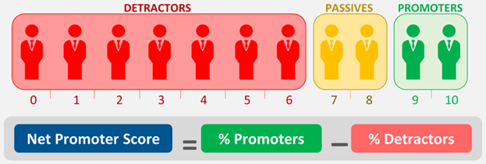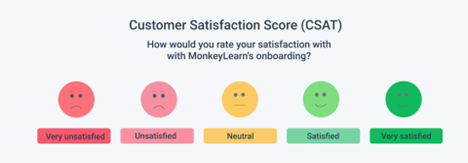OmniByte Customer ride-alongs allow our team to experience firsthand how our customers use our...
What is CSAT and why does it matter?
The days of competing on price are over. Customers expect fair value but are willing to pay for an overall better experience. Maybe you’re asking yourself – what is CSAT and why should I care?
CSAT is your Customer Satisfaction. And why it’s critical is clear, nearly 60% of customers say they are willing to pay more for a better customer experience. Your CSAT can be measured in several ways. This report aims to provide you with the information and details you need to help you formalize your CSAT strategy.
There are FOUR critical components to your CSAT strategy that we will dive into.
- Why high customer satisfaction metrics are critical to winning new business?
- What are the best practices regarding customer feedback data?
- When is the best time to collect customer feedback?
- Which mechanisms are best for customer feedback?
Higher customer satisfaction metrics are critical to winning new business?
If winning new business is part of your growth strategy for 2022 and beyond then your CSAT is going to play a role, whether you make it a priority or not. Some of the critical ways that CSAT can help your new business efforts include:
- Word of mouth: Customers are going to talk about your service good or bad. A recent study found that a good experience would be mentioned up to 9 times. While a bad experience would be discussed up to 16 times. You want (and need) that positive word of mouth.
- Increased loyalty: You may have heard the adage that keeping a customer is far less expensive than winning a new one. Part of your business strategy should be to keep your current customers and leaving them with a positive experience will deepen that brand loyalty.
- Increase productivity: A study came out that said brands with a higher CSAT can have a bump in productivity by as much as 20%. Your employees seeing and hearing about positive customer interactions will in turn help them work harder and those two things combined should lead to new business.
Best practices regarding customer feedback
As we mentioned previously there are several ways to measure your CSAT. No one way is right or wrong. You should consider your customers and their preferences when you build your CSAT strategy. But there are some basic ways that you can start to measure your customer’s current satisfaction.

Net Promoter Score (NPS): Your NPS is a single question survey that can be done in any number of ways. You can use email, SMS or a simple form tool to help track. Your NPS is the percent of promoters (9-10) minus your detractors percentage (0-6). A good NPS score is 0-30, while a score of 30-60 means your customers love your brand. A score below 0 indicates an issue with your service that needs to be addressed immediately.

Another option is a simple customer satisfaction survey. Keep it short and to the point. It can be as simple as a single question (like the example to the right). Or you can list out 5-8 questions about various elements of your business (communication, timeliness, ease of scheduling, etc) and use a format that is still based on a 1-5 or 1-10 so you can create a score for each of the areas.
Once you have your data to get your CSAT you need to perform some basic math. Divide your satisfied and very satisfied customers by the total number of respondents and multiple that number by 100. It’s that simple to get your score.

CSAT scores are based on your customer’s most recent encounter with your team. And your NPS score is ultimately the intent of your customer’s to recommend your brand/service to others. Both have merit and it is likely a good idea to use both of these methods.
Other options exist as well. Some more popular options might include:
- Social listening
- Sentiment analysis
- Customer effort score
- Market research
- Connect personally with customers
No matter what format you use, be consistent. Your CSAT score may shift and change, so you don’t want to be guessing if that change is because you changed the method(s). Find the options that work best for your organization and stick with it. Want to try something new—great, just make sure to keep using the tools that you have in place.
When is the best time to collect customer feedback?
This question will largely be based on your process and what you are most comfortable with. It may also depend on the mechanisms that you plan to use (more on that later). But, waiting until the end of a service call may not be the best approach. Can you get some feedback throughout the entire process? Maybe it starts with a simple question when the service is scheduled. Does your process have a follow up to confirm the appointment? If so, another great time to gather feedback and input from your customers.
A recent study done by Field Service News found the following:
- 33% of organizations wait until 24-hours after the call is completed
- 29% reach out within 24-hours
- 24% collect feedback directly from the engineer at the point of service
There is simply no “silver bullet”, you need to know and understand your customer and their preference and try to give them the ability to answer when they choose. Technology can help. If a customer wants to answer a short survey at the point of service, are you prepared? Will it be a paper form that then needs to be input later? Do your techs have the right tools to capture this data on the spot and make it actionable? If not, you will want to develop your strategy to allow for follow up after the call.
Your customers time to provide feedback should be valued. Think about how you can not only increase your response rate but also provide an incentive for future business? Maybe something as simple as a $10 coupon for their next service? This could be a win-win-win scenario for your customers, your data collection efforts and your ability to ensure future business from that customer.
Which mechanisms are best for customer feedback?
What’s the best way to engage your customer and get this incredibly valuable data? There are any number of ways that it can be done. Some of the top options might include email, SMS (texting), engineer while on site, direct mail and follow up calls. There is no right way or wrong way. Do what works for your organization and this is one area where you can try and experiment with some data gathering options and make decisions about what is and isn’t working.
You should try and build your strategy around what works best for your customers. If you have a large customer base that is 65+, using SMS (texting) might not be the best strategy. But if you target a younger audience SMS might be a great way to encourage your customers to fill out a quick survey.
In their recent study Field Service News found that the tactics listed below were “very effective” in terms of gathering CSAT data:
-
39% direct collection from engineer on site
-
37% email
The least effective method was SMS with only 16% of respondents saying it was “very effective”.
Again keep your customer in mind when you build out or make any changes to your CSAT strategy.
Summary
Does good customer service create a competitive advantage? Clearly it can. But this is going to be up to you and the decisions you make about your CSAT strategy. Don’t be afraid to try new approaches and test which technique helps get the most data. What you are looking for is being able to have this data to help make decisions around your entire business. This might include your pricing strategy, promotions, how you schedule, your follow-up post appointments, the technology that you deploy and so many other pieces and parts of your business.
Customers are willing to pay more for a better experience. Competing on price alone is a race to the bottom. It leads to cutting corners and creating the opposite of what customers expect. If they are willing to pay for a better experience then the focus can be on being the best service provider in your market – providing you with a competitive advantage that can’t be taken easily. Continue to look for ways to create that better experience and good things will likely follow for your organization.



